Menus
- BMW, Kawasaki, Triumph and Yamaha Tourer in comparison test
- MOTORCYCLE scoring / test results
- Technical specifications
- Performance measurement
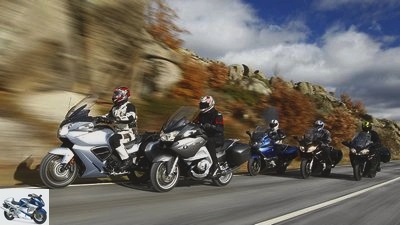
Gargolov

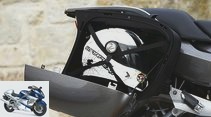
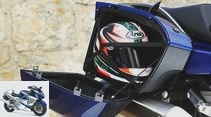
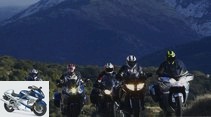
31 photos
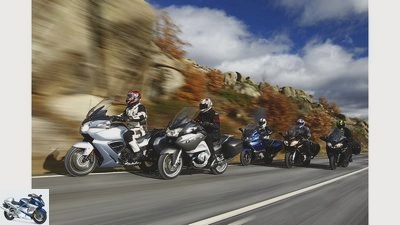
Gargolov
1/31
Tourer comparison test: Triumph Trophy SE, BMW R 1200 RT, BMW K 1600 GT, Yamaha FJR 1300 and Kawasaki 1400 GT.
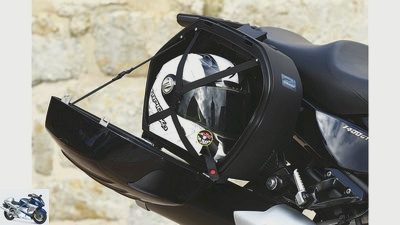
Gargolov
2/31
Kawasaki 1400 GTR – Stay on top: The Kawa cases are mounted high up because of the voluminous silencer.
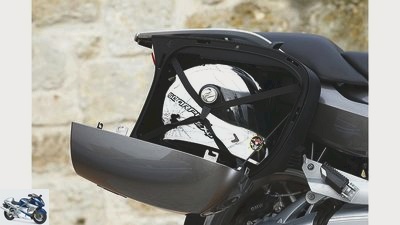
Gargolov
3/31
BMW R 1200 RT – Boxes for the Boxer: The Boxer BMW cases – spacious and tried and tested for years.
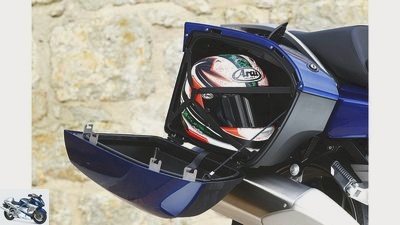
Gargolov
4/31
BMW K 1600 GT – Perfect: The fit of the GT case is fantastic. The boxes can be locked centrally.
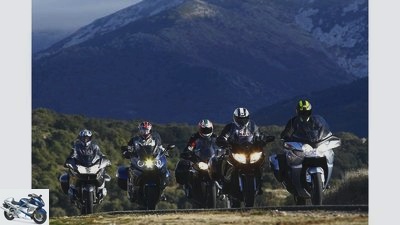
Gargolov
5/31
Even above the frost line, we loll our extremities, well-tempered by the seat and handle heating.
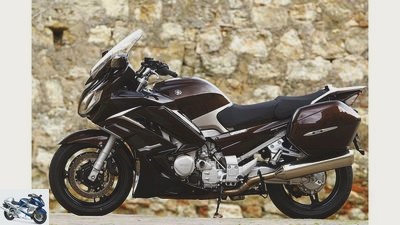
Gargolov
6/31
Yamaha FJR 1300 – Tradition: The slim silencers contribute a lot to the classic appearance of the FJR.
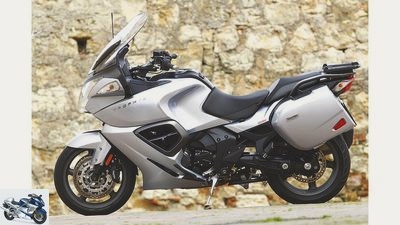
Gargolov
7/31
Triumph Trophy SE – Bulky: Not least because of the flat paneling, the Trophy makes a massive impression.
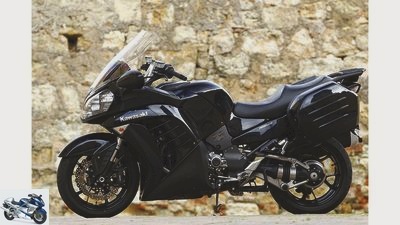
Gargolov
8/31
Kawasaki 1400 GTR – Elan: Highly mounted cases and the fairing fins give the GTR a sporty line.
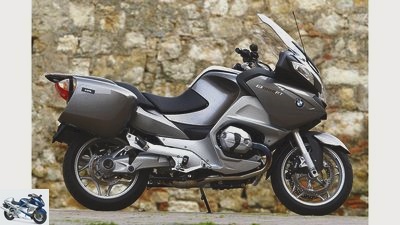
Gargolov
9/31
BMW R 1200 RT – Show me the second: Not only because of the cooling air – the fans should also see the boxer engine.

Gargolov
10/31
BMW K 1600 GT – Show me the first: Despite the fairing, the GT proudly displays its six-cylinder engine.
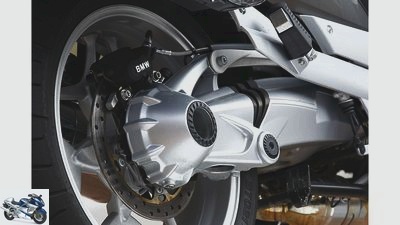
Gargolov
11/31
BMW R 1200 RT – Paralever, the second: The cardan of the boxer model is the only tourer on the right-hand side.
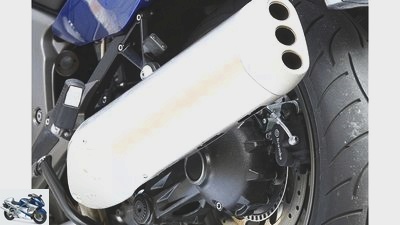
Gargolov
12/31
BMW K 1600 GT – Paralever, the first: the cardan shaft of the 1600 series BMW can hardly be seen, but felt on bumpy slopes.
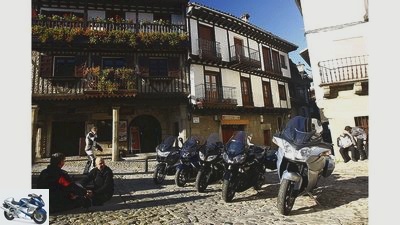
Gargolov
13/31
Oberammergau in Spain. La Alberca – capital of the world famous Jamón Iberico de Bellota.
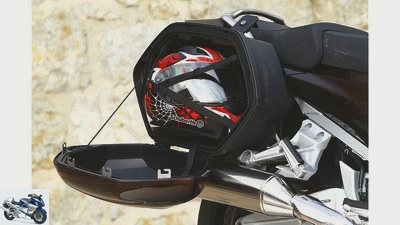
Gargolov
14/31
Yamaha FJR 1300 – exception: As the only case system on this tourer, the FJR boxes can only be attached and detached with a hook.
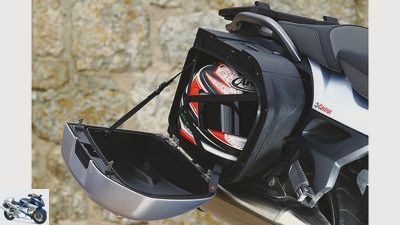
Gargolov
15/31
Triumph Trophy SE – high quality: the attachment of the SE case. The cases are also hung swinging.
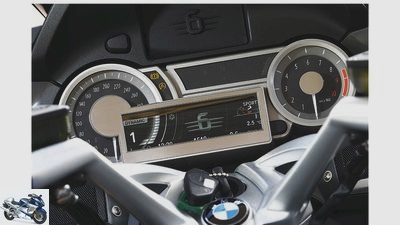
Gargolov
16/31
BMW K 1600 GT – Experience: the color TFT display of the large BMW tourer.
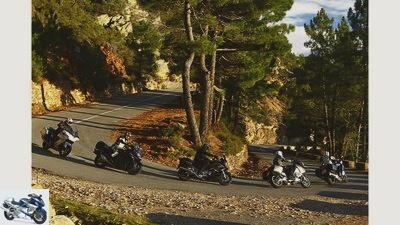
Gargolov
17/31
High-quality technology, unmatched driving comfort – without diluting the essential motorcycle driving experience.
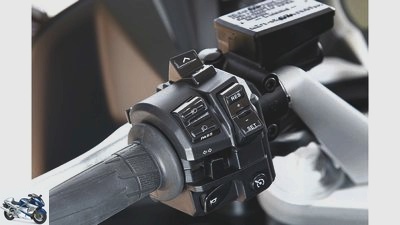
Gargolov
18/31
Yamaha FJR 1300 – Better: The FJR’s switch squadron is easier to operate than it looks.
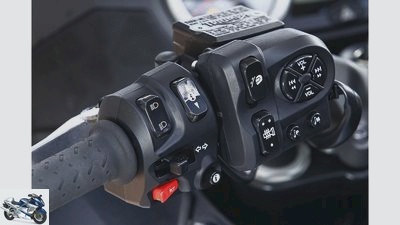
Gargolov
19/31
Triumph Trophy SE – Dimensions: The buttons control the menu navigation and the standard radio (right switch).
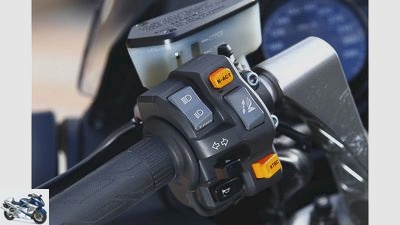
Gargolov
20/31
Kawasaki 1400 GTR – rule madness: Even composite brakes (above) and traction control (below) can be adjusted.
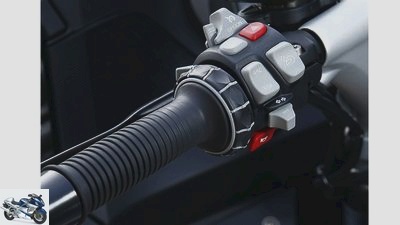
Gargolov
21/31
BMW R 1200 RT – BMW, the second: In order to keep the flood of switches at the end of the handlebars within limits, the technicians relocated some of the control buttons of the sound system to the fairing on both tourers. The indicator activation has followed the usual standard for a long time.
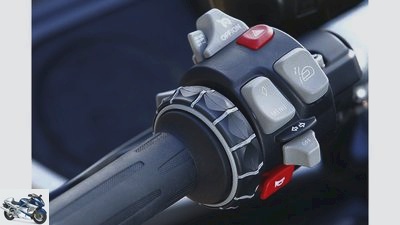
Gargolov
22/31
BMW K 1600 GT – BMW, the first: The radio can be controlled with the rotary wheel without letting go of the grip.
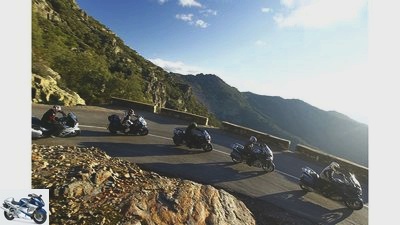
Gargolov
23/31
It is amazing how the designers have managed to make the more than six hundredweight of ballast almost disappear while driving.
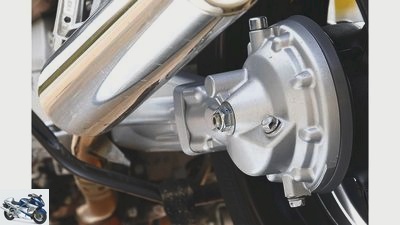
Gargolov
24/31
Yamaha FJR 1300 – Simple and effective: The no-frills cardan of the FJR is optically discreet and functionally first class.
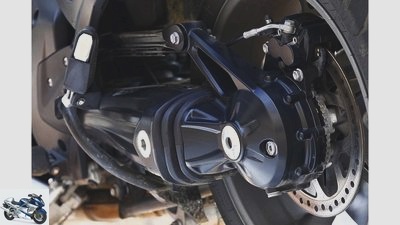
Gargolov
25/31
Triumph Trophy SE – Shared joy: The trophy takes over the reaction-free cardan drive from the travel enduro Explorer.
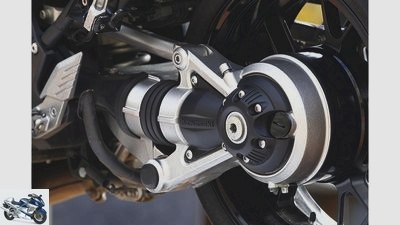
Gargolov
26/31
Kawasaki 1400 GTR – Tetra-Link: The Kawasaki relies on an elaborate torque support – the result is convincing.
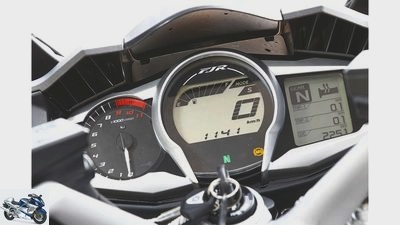
Gargolov
27/31
Yamaha FJR 1300 – Also for non-digital natives: easy-to-understand menu (right).
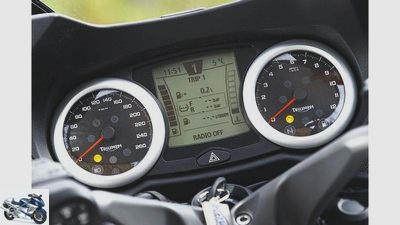
Gargolov
28/31
Triumph Trophy SE – A lot: a lot of information. Some a little awkward to find.

Gargolov
29/31
Kawasaki 1400 GTR – calm, the second: two round clocks with display.
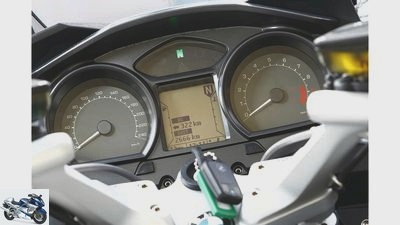
Gargolov
30/31
BMW R 1200 RT – calm, the first: two round clocks with digital display.
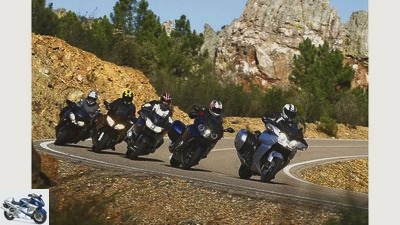
Gargolov
31/31
The BMW K 1600 GT wins the group test on the first-class roads in Spain.
Tourer comparison test
BMW, Kawasaki, Triumph and Yamaha Tourer in comparison test
Tourers represent the sophisticated way of traveling. And the prospects for this segment are good. Because the two top dogs from BMW are tackling Yamaha with the upgraded FJR 1300 and above all Triumph with the brand new Trophy SE.
W.he icing sugar covers the country road with a white veil. We carefully feel our way through the curves – these are the three colleagues from the Spanish and Danish sister papers and the two MOTORRAD editors. Because the fair complexion consists of road salt. Only yesterday it snowed here in the Sierra de Gredos, barely 150 kilometers west of Madrid. This wonderfully winding road only screwed us up a few hundred meters in altitude. And yet enough to swap late autumn in the Spanish capital, which is already 600 meters high, for an early winter in this mountain range.
Buy complete article
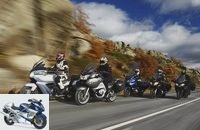
Tourer comparison test
BMW, Kawasaki, Triumph and Yamaha Tourer in comparison test
K 1600 GT again in the focus of interest in 2011. Because behind the Bavarian flagship, the competition has also set sail. Triumph is sending the brand new Trophy SE on the trip. The three-cylinder engine adopted from the travel enduro sits in an aluminum frame, the British model springs and dampens with an electronically adjustable chassis, boasts extensive equipment and wants to push its way forward in the tourist establishment with this overall package. Yamaha donated the classic FJR 1300 for the 2013 model year, in addition to a modified windshield and modified fairing front, an additional electronics package. Ride-by-wire throttle, traction control, cruise control and two driving modes are all down to the bits and bytes. In this respect, the BMW R 1200 RT and Kawasaki 1400 GTR, which were only renovated for the 2010 season, are already known as old friends. It’s a shame that the Honda Pan European apologized. Neither the German nor the Spanish importers have the somewhat aged bike that has hardly changed since 2002 in their press fleet.
The road towards Bejar loses height hardly noticeably. Finally no more salt. Finally enjoy the driving pleasure. Oh yes, keyword enjoyment. Where do we start? Motor, seating position, suspension, wind protection …? Every detail seems to be dedicated to this overarching goal for tourers.
You can’t help but enjoy. If only because the driver’s cab is more sublime and more relaxed than on any other type of motorcycle. Even on the two sportiest in the field, the Kawasaki and the Yamaha. Leaning forward slightly – more on the GTR, a little less on the FJR – the two of them place their staff, thus ensuring a good feeling for the front wheel, but giving it a bit of the tourer-typical feeling of space. Which you can experience almost to perfection on the rest of the trio. Invitingly they stretch the handlebars towards the master, suck him down into the depths of the fluffy benches and present their cockpits behind the towering windscreens, which look like the control center of an ocean liner. If the boxer BMW is already lush, the Triumph goes one better in this respect. The space is a bit more generous. But the greatest spatial experience is undoubtedly the K 1600 GT. The wheelbase (1618 millimeters), which is up to ten centimeters longer than that of the colleagues, is reflected in the command post. A truly generous place to work.
Gargolov
It is amazing how the designers have managed to make the more than six hundredweight of ballast almost disappear while driving.
The streets are also committed to enjoyment. First-class asphalt, wide lanes, hardly any traffic – and lots of curves. A dream. After all, between 282 kilograms (BMW R 1200 RT) up to a huge 342 kilograms (BMW K 1600 GT) need to be tilted and straightened up again. And yet it is not the weight of the Kawasaki (314 kilos) that our Spanish colleague and tour guide Sergio is struggling with. Even after the revision three years ago, the front of the 1400 GTR still feels heavy and slowly turns in. Klavs, the Dane on the Yamaha (303 kilos), turns corners much more effortlessly. The combination of the comparatively narrow 180 mm rear tire and the aforementioned slightly leaned forward riding posture conveys a lot of confidence and an almost sporty driving experience. Nevertheless: The grace of the late birth lets the heavyweight ranks with the K 1600 GT and the Trophy SE (314 kilos) overtake the Yamaha. It is amazing how the designers have managed to make the more than six hundredweight of ballast almost disappear while driving. Right, left, right. Above all, the Triumph gives you a full driving experience. Its front provides crystal-clear feedback and gives the pilot enormous confidence, while the Duolever wheel suspension of the big BMW initially requires a little empathy. But once you get used to the meager feedback, you soon gain confidence and let the K pull like a line through the curves. Of course, none of them can keep up with the almost nimble handling of the Boxer BMW in this environment. Maybe it’s due to the lengthways crankshaft, the narrowest knee joint, the said lowest weight or the comparatively narrow 180 cm rear tire, the fact is: no tourer can swing around corners lighter than the R 1200 RT. Even if – similar to its big sister – the Telelever front wheel control requires the driver to get used to.
We roll through El Barco de Ávila. The imposing, very well-preserved fortress at the city entrance is impressive. The bridge over the Río Tormes, also dating from the Middle Ages, spits us out towards Bejar. The road stretches. We take it easy and zap through the information centers. Like bees around an overripe apple, all conceivable forms of buttons, switches and sliders gather around the ends of the handlebars. Consumption, temperature, average speed, gear engaged, whatever – the digital displays give the answer. Terrific: the TFT display of the BMW K 1600 GT. The future belongs to this technology in terms of color and high contrast even when exposed to sunlight. Because digital natives, i.e. people who grew up in the digitized world, do not yet belong to the target group of Supertourer customers in terms of age, BMW has at least the on-board radio, sorry, the multimedia system (surcharge from 1000 euros), partly in one Button placket on the left half of the panel. Triumph (radio as standard) uses a rather bulky switch on the handlebar for this. Even if the sound of both BMWs and the Triumph sounds good, the sound remains embarrassing when driving through town.
So, sound it out. After all, even digital laypeople manage to raise all of the electrically adjustable windscreens. The windshield of the Yamaha is based on the sporty concept. Taller people who are bothered by the wind blowing on their helmets despite the shield being extended can certainly be helped by the taller disc from the Yamaha accessories program (240 euros). And while the Kawa’s shield, which was seven centimeters higher in the last model update, now confidently tames the hurricane, the trio of the two BMWs and the Triumph are once again setting the bar. The signs build up like transparent walls, ensuring calm in the extended position. In the case of the British, even a bit quieter than the Bavarian women. The disadvantage: When swinging around bends, the upper edges disturb the view and the lens position has to be readjusted – at the push of a button, of course.
Behind the town of Bejar, which is known for its fabric production, the road gradually begins to ripple again. The sovereignty with which these cars take the turns of all radii is astonishing again. Great. It goes without saying that it is also the massive, high-torque motors that help to shift the dimensions in this field. Despite 1170 cm³ displacement and 108 measured horsepower, the boxer of the R 1200 RT is, so to speak, the dinghy among the luxury liners. Actually a quiet representative of its kind, the Flattwin gives the Rappelphilipp here in the field. In no way uncomfortable, but audibly pulsating, he pushes the RT, is lively and has an easy job with the – again comparatively – moderate 282 kilos. And still has to admit defeat. From the 1215 cc Triumph three-cylinder anyway. The smooth running and the sound of the 132 hp triplet cannot be denied that it is a certain experience value. He pushes cleanly from idle speed, can be shifted through crisp, depends great on the gas – and still struggles with his pounds. One would not have expected the worst acceleration values of the quintet with the subjectively impressive package.
Gargolov
Oberammergau in Spain. La Alberca – capital of the world famous Jamón Iberico de Bellota.
With the competition, it’s no wonder. The Kawasaki four-cylinder presses 153 hp on the dynamometer roller. And as powerful as this value, so vehemently the in-line quad equipped with variable valve control lays its stuff on the road, pushing the ensemble with its mountain of torque forward. The fact that the slightly weaker Yamaha unit with 140 hp is still ahead in this respect is due to the latest facelift. The electronic throttle valve actuation alone, or ride-by-wire, has done a lot for the FJR engine. Instead of a previously rough response due to the unfortunate selection of the throttle transmission, the 1298 cc four-cylinder now accelerates gently, even in sport mode, and unfolds its highly cultivated potential. Top notch – if BMW hadn’t come up with this magnificent six-cylinder. Whether the hissing sound, the almost perfect running smoothness, the broad power range, 1649 cm³ displacement or measured 159 hp – the BMW six concentrates all superlatives on itself. The fact that in this form, in full touring regalia, he easily accelerates all current 1000cc superbikes from standstill to 100 km / h sets the final chord for this splendid performance. A horse’s foot: The six-pack also holds the record when it comes to transmission. That of the loudest to be switched gangbox.
It is evening. We are approaching Cuidad Rodrigo, only 25 kilometers from the Portuguese border. In front of the Castillo de Enrique II we click the suitcases out of their holders. Again demonstrate the noble planer quality. The boxes convince with high-quality production, well-fitting, tension-free attachment and one-key system. Only the Yamaha disappoints. Not all full-face helmets fit in the case, which has a capacity of just 30 liters, and mounting and dismantling are extremely tricky.
The next morning. Frost covers the machines. What the heck, we’re on the road with Pullman trips. The streets are still spreading out before us as smoothly as curled dough. Oh yes, Spain is one of the largest recipient countries in the EU. Only for the road to La Alberca does not seem to have been a euro. The provincial road winds its way through the forest. One push of a button – what else? – is enough to switch the two BMWs to “Comfort”. The ESA II reacts immediately, effectively sucking away the potholes with lower spring preload and softer damping. The ESA counterpart called TES is hidden deeper in the menu of the on-board computer at Triumph. The system manufactured by WP Suspension – a subsidiary of KTM, by the way – also reacts effectively to the changes, and with the conventional wheel suspensions it offers even more feedback. Very well. The Kawa and the Yamaha follow at a distance. Instead of using TES and ESA, you have to be content with the manual adjustment options of the widely spread adjustment ranges of the fork and shock absorber. Certainly feasible and not rocket science, but a bit more old-fashioned in direct comparison.
Gargolov
High-quality technology, unmatched driving comfort – without diluting the essential motorcycle driving experience.
Especially since both the GTR and the FJR, which was streamlined for 2013, still offer noticeably less comfort than the rest of the trio, even after the readjustment at the roadside. Irony of fate: Of all things, the two technically unspectacular cardan drives, the Triumph and the Yamaha, react the most inconspicuously on the bumpy road, while the Kawa hack the transmission with moderate, but the two BMWs with powerful metallic hits.
Sergio doesn’t let that slow him down, ironing quickly over the waves. It’s great how the pitch compensation of the two BMW fronts keeps the noses of the machines up even when braking, while Kawa, Triumph and Yamaha work deeply into their suspension travel. In these situations the compound brakes of the five don’t really matter. Only the Kawa always combines hand and foot brakes, Triumph and Yamaha only brake at the front with their hand, but brake both wheels with their foot, the two BMWs brake with the hand lever at the front and rear, with the foot brake only at the rear. Sounds confusing. Sensitive corrective braking with the rear wheel brake works best – logically – with the uncoupled BMW stoppers and the Triumph combination brake, which is finely tuned via a proportional valve. The Kawa and the Yamaha tend to stand up due to the noticeable engagement of the front brake. When it comes to ABS, too, the Kawa and Yamaha can take a little butter off the bread, reacting to extreme delays with rather rough control intervals.
With its half-timbered buildings, La Alberca exudes the charm typical of mountain villages. Only now do we remember the pig pastures in the woods again. The place with 1200 inhabitants is a stronghold of the Jamón Iberico de Bellota, a delicious ham, made exclusively from the meat of free-roaming pigs fed on acorns. Short photo stop – and let’s go. We swing for many more kilometers before the roads stretch to the east again.
A gas station. Luis on the kawa flashes. The highest consumption (6.2 liters) and the smallest tank (22 liters) form an unpleasant alliance with the GTR. Of course, a range of 355 kilometers can be seen in itself, but in the context of the much more economical (5.2 to 5.5 liters) and better stocked (24 to 26 liters) long-distance runners, the Kawa is still a weakness.
We rise. Nothing beats a secure stance with the bumpers. Every millimeter is noticeable. The low seat height of the Yamaha (795 millimeters) is pleasantly noticeable, as is that of the K 1600 GT (800 millimeters). And it’s nice that everyone except Kawasaki is also thinking of the big guys. The seat cushions can be raised up to 30 millimeters (see technical data on page 28) without tools.
Gargolov
Even above the frost line, we loll our extremities, well-tempered by the seat and handle heating.
In general, the sporty Kawa strangers to the tourists. Inspection intervals of 6000 kilometers are not even enough for some hardcore bikers for a summer vacation. He should be pale with envy on the occasion of the 16,000 intervals of triumph anyway.
“Madrid 120 km” is emblazoned on the sign. Mostly expressways. Lean back and think. Entry into the world of luxury liners costs just under 18,000 euros, and a first-class ticket on the six-cylinder BMW is almost 24,000 euros. Truly a lot of money. But there is more motorcycle than ever in the touring segment. High-quality technology, lots of electronic assistance systems and unmatched driving comfort – and all of this without watering down the essential motorcycling feeling too much. The fact that Kawasaki and Yamaha emphasize the subject of sportiness with their tourers is a matter of interpretation. From a travel point of view, Newcomer Triumph has achieved the planned coup. The Trophy SE established itself straight away in the tourist league, beating its opponent, the BMW R 1200 RT, in a direct duel. Nobody else would have expected that the six-cylinder BMW is beyond doubt anyway. It is no coincidence that the K 1600 GT is the best in points of all machines ever tested by MOTORRAD. Oh dear, on the outskirts of Madrid the traffic jam brings us to a standstill! The fact that we can hardly squeeze through the lines with our wide suitcases doesn’t even bother the hot-blooded Sergio, we sit well – in the Pullman armchair.
MOTORCYCLE scoring / test results
Gargolov
BMW K 1600 GT – Show me the first: Despite the fairing, the GT proudly displays its six-cylinder engine.
| Max points | BMW R 1200 GT | BMW K 1600 GT | Kawasaki 1400 GTR | Triumph Trophy SE | Yamaha FJR 1300 | |
| Overall rating | 1000 | 717 | 769 | 685 | 733 | 715 | placement | 3. | 1. | 5. | 2. | 4th. |
| Price-performance note | 1.0 | 2.7 | 3.1 | 3.0 | 2.8 | 2.6 |
MOTORCYCLE test results
1 BMW K 1600 GT
She is the strongest, the most sophisticated, the most comfortable and the best equipped. Given these qualities, she will be forgiven for being the most expensive. The BMW six-pack travels in a league of its own.
2 Triumph Trophy SE
The cultivated three-cylinder, the high-quality and extensive equipment and, above all, the successful driving dynamics catapult the trophy straight to the boardroom. The British can do it.
3 BMW R 1200 RT
Three years ago she was still at the top of the travel agency. It still impresses with great features and the best handling. But with the relatively tame boxer engine, the RT now has to give in.
4 Yamaha FJR 1300
She interprets the topic of tours in a sporty way – and therefore loses ground in the core competencies (wind protection, suspension). Nevertheless: The revision has done the FJR good in every respect.
5 Kawasaki 1400 GTR
The GTR also has a sporty touch. The powerful engine is convincing, the equipment is valuable. The sluggish, front-heavy steering behavior doesn’t match the sporty line – but neither does the tourist line
Technical specifications
Gargolov
The BMW K 1600 GT wins the group test on the first-class roads in Spain.
| BMW R 1200 RT | BMW K 1600 GT | |
| engine | ||
| design type | Two-cylinder four-stroke boxer engine | Six-cylinder four-stroke in-line engine |
| injection | Ø 47 mm | Ø 52 mm |
| coupling | Single-disc dry clutch | Multi-disc oil bath clutch |
| Bore x stroke | 101.0 x 73.0 mm | 72.0 x 67.5 mm |
| Displacement | 1170 cm3 | 1649 cm3 |
| compression | 12.0: 1 | 12.2: 1 |
| power | 81.0 kW (110 hp) at 7750 rpm | 118.0 kW (161 hp) at 7750 rpm |
| Torque | 120 Nm at 6000 rpm | 175 Nm at 5250 rpm |
| landing gear | ||
| frame | load-bearing motor-gear unit | Bridge frame made of aluminum |
| fork | telescopic fork, Ø 35 mm | Double longitudinal control arm made of aluminum |
| Brakes front / rear | Ø 320/265 mm | Ø 320/320 mm |
| Assistance systems | Partly integral braking system with ABS traction control |
Partly integral braking system with ABS traction control |
| bikes | 3.50 x 17; 5.50 x 17 | 3.50 x 17; 6.00 x 17 |
| tires | 120/70 ZR 17; 180/55 ZR 17 | 120/70 ZR 17; 190/55 ZR 17 |
| Tires | Bridgestone BT 021 | Metzeler Z 8 Interact, back “C” |
| Dimensions + weights | ||
| wheelbase | 1485 mm | 1618 mm |
| Steering head angle | 63.4 degrees | 62.2 degrees |
| trailing | 110 mm | 106 mm |
| Front / rear suspension travel | 120/135 mm | 135/115 mm |
| Seat height ** | 830-850 mm | 800-830 mm |
| Weight with full tank ** | 282 kg | 342 kg |
| Payload ** | 213 kg | 198 kg |
| Tank capacity / reserve | 25.0 liters | 24.0 liters |
| Service intervals | 10000 km | 10000 km |
| price | 16550 euros | 20,200 euros |
| Price test motorcycle | 19485 euros *** | 23,300 euros **** |
| Additional costs | 390 euros | 390 euros |
| MOTORCYCLE readings | ||
| Top speed * | 223 km / h | 250 km / h |
| acceleration | ||
| 0-100 km / h | 3.9 sec | 2.9 sec |
| 0-140 km / h | 6.1 sec | 5.0 sec |
| 0-200 km / h | 15.3 sec | 10.2 sec |
| Draft | ||
| 60-100 km / h | 4.8 sec | 3.7 sec |
| 100-140 km / h | 4.9 sec | 3.9 sec |
| 140-180 km / h | 6.8 sec | 4.1 sec |
| Consumption highway | 5.2 liters | 5.3 liters / super |
| Reach country road | 481 km | 453 km |
| Kawasaki 1400 GT | Triumph Trophy SE | Yamaha FJR 1300 | |
| engine | design type | Four-cylinder four-stroke- In-line engine |
Three-cylinder four-stroke- In-line engine |
Four-cylinder four-stroke- In-line engine |
| injection | Ø 40 mm | Ø 46 mm | Ø 42 mm | coupling | Multi-disc oil bath clutch | Multi-disc oil bath clutch | Multi-disc oil bath clutch |
| Bore x stroke | 84.0 x 61.0 mm | 85.0 x 71.4 mm | 79.0 x 66.2 mm | Displacement | 1352 cm3 | 1215 cm3 | 1298 cm3 |
| compression | 10.7: 1 | 11.0: 1 | 10.8: 1 | power | 114.0 kW (155 PS) at 8800 rpm |
99.0 kW (135 hp) at 8900 rpm |
107.5 kW (146 hp) at 8000 rpm |
| Torque | 136 Nm at 6200 rpm | 120 Nm at 6450 rpm | 138 Nm at 7000 rpm | landing gear |
| frame | Bridge frame made of aluminum | Bridge frame made of aluminum | Bridge frame made of aluminum | fork | Upside-down fork, Ø 43 mm | Upside-down fork, Ø 43 mm | Telescopic fork, Ø 48 mm |
| Brakes front / rear | Ø 310/270 mm | Ø 320/282 mm | Ø 320/282 mm | Assistance systems | Partly integral braking system with ABS traction control |
Partly integral braking system with ABS traction control |
Partly integral braking system with ABS traction control |
| bikes | 3.50 x 17; 6.00 x 17 | 3.50 x 17; 6.00 x 17 | 3.50 x 17; 5.50 x 17 | tires | 120/70 ZR 17; 190/50 ZR 17 | 120 / 70R 17; 190 / 55R 17 | 120/70 ZR 17; 180/55 ZR 17 |
| Tires | Bridgestone BT 021 “U” | Pirelli Angel ST, front “A” | Bridgestone BT 023 “F” | Dimensions + weights |
| wheelbase | 1520 mm | 1542 mm | 1515 mm | Steering head angle | 63.9 degrees | 63.0 degrees | 64.0 degrees |
| trailing | 112 mm | 119 mm | 109 mm | Front / rear suspension travel | 113/136 mm | 127/120 mm | 135/125 mm |
| Seat height ** | 820 mm | 820-835 mm | 795-815 mm | Weight with full tank ** | 314 kg | 317 kg | 303 kg |
| Payload ** | 218 kg | 237 kg | 201 kg | Tank capacity / reserve | 22.0 liters | 26.0 liters | 25.0 liters |
| Service intervals | 6000 km | 16000 km | 10000 km | price | 17,495 euros | 18670 euros | 17,395 euros |
| Price test motorcycle | 17,495 euros | 19792 euros ***** | 17,395 euros | Additional costs | 180 euros | 370 euros | 230 euros |
| MOTORCYCLE readings | Top speed * | 246 km / h | 214 (2231) km / h | 245 km / h |
| acceleration | 0-100 km / h | 3.2 sec | 4.0 sec | 3.1 sec |
| 0-140 km / h | 5.2 sec | 6.6 sec | 5.4 sec | 0-200 km / h | 10.4 sec | 14.7 sec | 11.9 sec |
| Draft | 60-100 km / h | 5.6 sec | 5.2 sec | 4.4 sec |
| 100-140 km / h | 5.0 sec | 5.5 sec | 4.3 sec | 140-180 km / h | 6.4 sec | 7.7 sec | 5.0 sec |
| Consumption highway | 6.2 liters | 5.3 liters | 5.5 liters | Reach country road | 355 km | 491 km | 455 km |
* Manufacturer information; ** MOTORCYCLE measurements; *** incl. Safety package (430 euros) consisting of: ASC and RDC; Touring package (1505 euros) consisting of: ESA, chrome-plated exhaust system, heated grips, heated seats, cruise control, on-board computer and 2nd socket; Audio system (1000 euros); **** incl. Safety package (860 euros) consisting of: DTC, RDC and adaptive headlights; Comfort package (1130 euros) consisting of: ESA, central locking and anti-theft alarm system; Audio system (1110 euros); ***** incl. Touring windshield (215 euros), heated grips (185 euros), heated driver’s / co-driver’s seat (298/279 euros), luggage rack (145 euros)
Performance measurement
archive
Power on the crankshaft. Measurements on the Dynojet roller test stand 250, corrected according to 95/1 / EG, maximum possible deviation ± 5%.
The six-cylinder engine of the BMW K 1600 GT is in a league of its own with 159 hp and 174 Nm maximum torque. It goes without saying that the engine concept combines this performance with well-kept running culture. The – at least in the last gear – very long translation blocks the view of the impressive performance and the exemplary torque curve of the Kawasaki. With the introduction of the ride-by-wire throttle valve actuation in the 2013 model year, the power of the Yamaha can also be perfectly controlled. However: With 140 hp, the FJR four-cylinder lacks six hp for the promised nominal power. In contrast, the three-cylinder Triumph feels subjectively stronger. The spontaneous pushing of the triplet suggests more torque than the measured 117 Nm. The R 1200 RT propellant delivers the camel hump in the torque curve that is typical of boxer engines. However, this irregularity can hardly be felt on the street.
Related articles
-
BMW F 800 GS and Triumph Tiger 800 XCx in comparison test
fact 37 photos fact 1/37 Triumph Tiger 800 XCx. triumph 2/37 Not a bargain, but a two plus proves: The Triumph Tiger 800 XCx offers a lot of technology…
-
BMW, Kawasaki, Yamaha and Honda Tourer in comparison
Kunstle 21 pictures 1/21 The story of a seven-day trip with a simultaneous comparison test around the Baltic Sea with the tourers: BMW K 1600 GT, …
-
Kawasaki, KTM, Triumph and Yamaha
Jahn 20 pictures Triumph 1/20 Triumph 2/20 From the development phase: a model with a low-lying silencer. Triumph 3/20 Triumph 4/20 The …
-
Tourer BMW R 1200 RT, Triumph Trophy 1200 SE and Yamaha FJR 1300 AE in the test
Bilski 51 photos Bilski 1/51 We have chosen a very special location for the top tourer comparison test. Bilski 2/51 The Gorges de Galamus are a gorge…
-
Triumph, Harley Davidson, Kawasaki and Honda Cruiser in the test
Jahn Chopper from Triumph, Harley Davidson, Kawasaki and Honda in the test Comparative test of mid-range cruisers up to 9,000 euros In the field of cruisers, the …
-
Aprilia RSV4 RF and Yamaha YZF-R1M in comparison test
40 photos markus-jahn.com 1/40 Aprilia RSV4 RF and Yamaha YZF-R1M in comparison test. markus-jahn.com 2/40 You sit quite high on both bikes, but with the…
-
Triumph Daytona 675, Kawasaki ZX-6R 636 and Suzuki GSX-R 750 in the test
fact 20th photos fact 1/20 Super athletes with less than 1000cm³ in the comparison test. Suzuki GSX-R 750, Kawasaki ZX-6R 636 and Triumph Daytona 675….
-
Sports tourer concepts in a comparison test
www.factstudio.de 29 photos www.factstudio.de 1/29 Experience German-German history: The heavily secured border with wall and barriers between East and…
-
Jahn 34 photos Jahn 1/34 Jahn 2/34 Lonely: The KTM is the only one of the adventure enduro bikes to stay with the chain drive. Light, but in need of…
-
BMW F 800 R, Kawasaki Z 800, MV Agusta Brutale 800 and Yamaha FZ8 in the test
Jahn 29 photos Jahn 1/29 A comparison of four 800 class motorcycles: BMW F 800 R, Kawasaki Z 800, MV Agusta Brutale 800 and Yamaha FZ8. Jahn 2/29 Like…